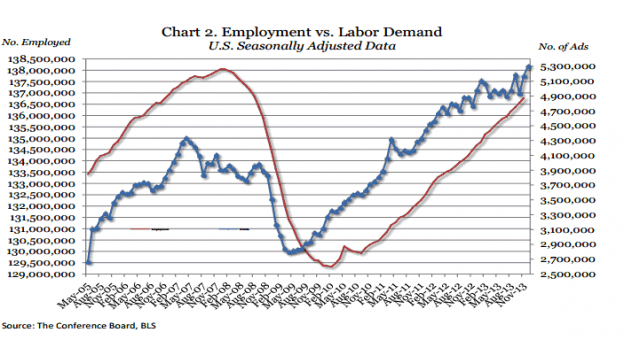The temp help index we follow has been signaling this trend for some time now. It is good however to see that the correlation remains. I’m quite sure we will see continued gains as we head into spring (note the series is volatile so do not get too hung up either way based on one month’s data). The main point here is that with auto sales remaining high, home construction increasing and both rail traffic and temp employment increasing, the economy is gaining strength. As these metrics strengthen we can expect continued employment gains which will fuel additional economic activity.
From the Conference Board
For Immediate Release 10:00 AM ET, Wednesday, January 8, 2014
December’s rise brings the 2013 gain to 27,000/month with greater growth in the last six months
Demand rose in December in 36 of the 50 States
NEW YORK, January 8, 2014…Online advertised vacancies were up 125,600 in December to 5,297,100, according to The Conference Board Help Wanted OnLine® (HWOL) Data Series released today. The November Supply/Demand rate stands at 2.1 unemployed for each vacancy with a total of 5.7 million more unemployed workers than the number of advertised vacancies.
“In 2013, labor demand in the first half of the year was flat but was more upbeat in the last six months with gains in a number of occupations,” said June Shelp, Vice President of The Conference Board. In the June-December time frame advertised vacancies for workers in the professional category gained 117,000 after declining 50,000 in the first half. Advertised vacancies for workers in the service jobs gained 234,000 in the last half of the year following a gain of only 27,000 in the first half. “These gains have helped whittle the unemployment number as more and more workers found employment,” said Shelp. The overall demand for labor has hovered around 5 million per month in 2013. The largest numerical gains in the last half of the year in the services/production group were for sales workers (+126,400) and transportation workers (+48,300); however, production workers (+8,000) and construction workers (-10,500) showed disappointing results. In the professional category, the largest gains were for managers (+49,100) and healthcare professionals (+36,600).
